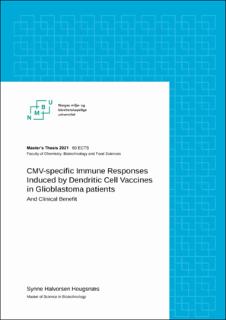| dc.contributor.advisor | Inderberg, Else-Marit | |
| dc.contributor.advisor | Diep, Dzung | |
| dc.contributor.advisor | Wälchli, Sébastien | |
| dc.contributor.author | Hougsnæs, Synne Halvorsen | |
| dc.date.accessioned | 2021-11-01T13:18:42Z | |
| dc.date.available | 2021-11-01T13:18:42Z | |
| dc.date.issued | 2021 | |
| dc.identifier.uri | https://hdl.handle.net/11250/2826921 | |
| dc.description.abstract | Glioblastoma multiforme (GBM) is a WHO grade IV malignant glioma and is the most common primary brain tumor. It has one of the poorest prognoses of all cancers, with a median survival of <15 months despite standard therapy with maximal surgical resection followed by radiotherapy and temozolomide treatment. Therapies intended to boost the patient's immune system, such as vaccine-based immunotherapies, have shown promising results in prolonging progression free survival and overall survival in many cancers, including GBM.
Six patients diagnosed with GBM who received dendritic cell (DC)-vaccinations against CMVpp65 protein, telomerase reverse transcriptase (hTERT) peptides, and survivin peptides were tested for immune responses before and after each vaccination to see if immune responses could be induced by the vaccines and if it had an impact on the survival. This was investigated by proliferation assays, ELISpot assays, and flow cytometry looking at T cell activation and function. Peripheral blood mononuclear cells (PBMCs) and tumor-infiltrating lymphocytes (TILs) were analyzed by mass cytometry to investigate local immune activity.
All patients showed induced immune responses against at least one of the vaccine antigens in either proliferation assays or IFN-γ ELISpot assays. The strongest responses in the patients were against the CMVpp65 protein, and one patient also showed increased IFN-γ production against hTERT peptide mix in the ELISpot assay. Intracellular staining followed by flow cytometry showed that the T cells produced TNF-α and/or IFN-γ in response to their cognate antigen, and there was a mix of cytokine producing CD8+ and CD4+ T cells, depending on the patient and antigen. Mass cytometry of PBMCs and TILs, where available, also showed expression of different markers indicative of activation and/or previous exposure to antigens. Although there were too few patients included in this study to conclude, the results suggest that immune responses were induced by DC vaccines. One of the patients had an overall survival of 40 months, and this patient had the most detectable responses, especially against CMVpp65 protein, and the highest amount of DC vaccines. | en_US |
| dc.description.abstract | Glioblastom (GBM) er en WHO-grad IV malign gliom og er den vanligst primære hjernesvulsten. GBM har en av de dårligste prognosene av alle krefttyper, med en median overlevelse på <15 måneder, til tross for standard terapi med kirurgi, strålebehandling og cellegiften temozolomid. Terapier som skal øke pasientens immunsystem, som vaksinebaserte immunterapier, har vist lovende resultater i å forlenge progresjonsfri og total overlevelse i mange kreftformer, inkludert GBM.
Seks pasienter diagnostisert med GBM mottok dendrittisk celle vaksinasjoner mot CMVpp65 protein, telomerase revers transkriptase (hTERT) peptider og survivin peptider i tidsperioden 2014-2016. Immunresponser mot disse peptidene ble undersøkt ved å teste perifere mononukleære blodceller (PBMC) fra tidspunkter før og etter vaksinene i proliferasjonstester og ELISpot, og ved å se på T celle aktivering og funksjon ved hjelp av flow cytometri. PBMC og tumorinfiltrerende lymfocytter ble også analysert ved hjelp av massecytometri for å undersøke lokal immunaktivitet. Dette ble undersøkt for å se om immunresponser kunne bli indusert ved hjelp av vaksinene og om dette påvirket overlevelse.
Alle pasientene viste induserte immunresponser mot minst et av vaksineantigenene i enten proliferasjonstest eller ELISpot. De sterkeste responsene var mot CMVpp65 proteinet, og en av pasientene viste også økt IFN-γ produksjon mot hTERT peptidmiks i ELIspot testen. Intracellulær farging etterfulgt av flow cytometri viste at T cellene produserte TNF-α og/eller IFN-γ i respons til deres spesifikke antigen, og det var en blanding av CD4+ og CD8+ T celler som produserte cytokinene avhengig av pasienten og antigenet. Massecytometri av PBMC og tumorinfiltrerende lymfocytter, der det var tilgjengelig, viste også at cellene uttrykte ulike markører som indikerte at cellene var aktiverte eller hadde blitt eksponert for antigen. Selv om det var for få pasienter i dette studiet til å konkludere, tyder resultatene på at immunresponser ble indusert av DC vaksinene. En av pasientene hadde en total overlevelse på 40 måneder, og denne pasienten hadde også flest detekterbare responser, spesielt mot CMVpp65 protein, og det høyeste antallet DC vaksiner. | en_US |
| dc.language.iso | eng | en_US |
| dc.publisher | Norwegian University of Life Sciences, Ås | en_US |
| dc.rights | Attribution-NonCommercial-NoDerivatives 4.0 Internasjonal | * |
| dc.rights.uri | http://creativecommons.org/licenses/by-nc-nd/4.0/deed.no | * |
| dc.title | CMV-specific immune responses induced by dendritic cell vaccines in glioblastoma patients | en_US |
| dc.type | Master thesis | en_US |
| dc.description.localcode | M-BIOTEK | en_US |

